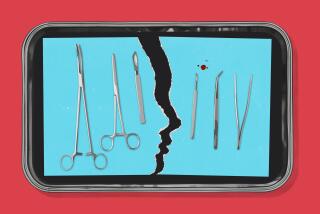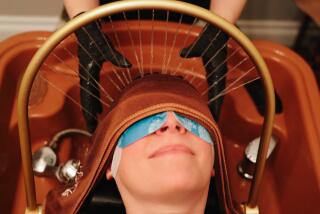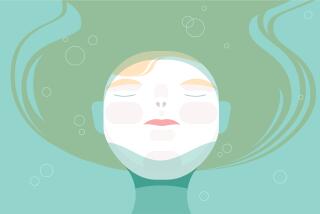In Good Hands? : As nail salons proliferate, so do health problems. Industry watchers worry about unsafe conditions, unlicensed operators.
- Share via
It starts with a tiny green spot--like a dot of ink under the fingernail--but soon blackens and spreads. As the infection swells, the nail is pushed up and off its bed. The intense pain ends only with surgical removal of the nail.
“It’s very gross, very ugly, very dangerous,” says Shirley Cranford, a state investigator who sees the not-so-beautiful side of California’s massive nail care industry.
And there is a lot to see: Fingers and toes discolored by fungus, infected nails that fall off and never grow back, feet scarred by forbidden callus blades, painful inflammations, dangerous reactions to illegal chemicals.
Much of the damage is at the hands of unlicensed manicurists and those--licensed or not--who fail to maintain safe and sanitary conditions. Although the majority of nail salons are safe, the number operating outside the law is “not small,” according to state officials, who have no estimates on illegal activity. But, says Cranford, the numbers are “definitely growing. . . . These unlicensed and unscrupulous operators put women, and men, at risk for serious injury and even life-threatening disease.”
Industry leaders, anxious to rid their ranks of dangerous operators, are lobbying nationwide for better salon surveillance by health boards.
Cyndy Drummey, editor of NAILS magazine, says, “There are many safe and careful nail salons. But the unsafe ones are endangering not only consumers but the whole industry.”
While California is considered by industry leaders to be among the most aggressive states in regulating the nail care business, enforcement is largely cosmetic because of a shortage of inspectors. The state Board of Cosmetology has just four inspectors to monitor 26,000 beauty shops, nail salons, and electrolysis parlors.
The need for more surveillance is critical, says Denise Ostton-Brown, executive director of the board. “In 1970, we had 8,710 licensed manicurists. By July of this year, we had more than 51,000,” she says.
“We simply cannot keep up. While many salons are safe, there is no question there must be a great deal of caution at the consumer level.”
By training and by nature, registered nurse Tish Schwinn is a cautious person. With patients, she wears latex gloves and sometimes eye gear, a mask and gown to protect herself from exposure to such blood-borne diseases as AIDS and hepatitis B.
Yet, she has been less vigilant about her regular visits to the nail salon. Early this year, the nails on both her big toes had to be removed because of a fungus.
The nails had been an “icky yellow-green color” for nearly a year, Schwinn says, when she finally went to a podiatrist.
“I’d been having pedicures just about every month and every time the polish came off, I’d ask ‘Why is it like that?’ And the pedicurist would say she didn’t know and put on some more polish.
“Everybody is freaking out about their dentists and doctors but we don’t think twice about turning our hands and feet over to people with sharp instruments who we know nothing about. . .”
While the Centers for Disease Control report no documented cases of salon-transmitted cases of hepatitis B and the AIDS virus, CDC spokesmen say there is “a potential risk.”
Infections are among the most common nail care risks--especially viral, bacterial or fungal infections that can incubate beneath the popular acrylic or other artificial, applied fingernails, says Dr. Lawrence Norton, dermatology professor at Boston University.
“When (artificial) nails get water under them, it creates a wonderful cesspool for bacteria,” says Norton. “That’s when we see the green, yellow, foul-smelling nails.”
Most infections can be successfully treated with antibiotics and steroids. But sometimes, the damage is permanent.
“There is no question that some medical problems come from the client’s own failure to properly maintain her acrylic nails,” says Shirley Thomas, enforcement coordinator for California’s cosmetology board. “But some infections definitely begin with negligent, poorly trained or completely untrained nail technicians.”
Although the risk of spreading blood-borne disease during a manicure or pedicure is remote, the possibility rises with the number of sticks and pricks that draw blood.
In California, manicurists and pedicurists must complete 350 hours of classroom and on-the-job training and pass a one-time five-hour examination that tests their understanding of the regulations and their knowledge of nail care technique.
Portions of the test might be given in Spanish and occasionally in Vietnamese, but the tests primarily are given in English and those who do not understand English are permitted to bring a translator.
Still, because of the shortage of inspectors and a keen awareness of that shortage, some operators do not bother to become licensed at all. Such operations, say industry experts, are more likely to pose serious health risks to customers.
“There’s no question about it. The unlicensed places are a threat to everyone,” says Karen Lessler, president of the National Nail Technicians Group. “It costs money to run a professional salon. It takes effort to train personnel, to run a place that creates a safe environment for the consumer. The fly-by-nighters don’t do that and can’t do that, but they are driving some good salons right out of the business.”
Shirley Cranford, who investigates unsafe nail salons for the state Department of Consumer Affairs, says the salons are one of the easiest businesses to operate illegally. “All you have to do is rent a shop--usually on a short-term lease, buy a table and a light to sit at and buy enough products to get you through the day.
“(But) we simply don’t have the people to go out and clean up the business,” Cranford says. “Heck, we don’t even know where most of the (unlicensed) business is.”
Operating a nail salon or performing nail care services without a license is a misdemeanor, punishable by imprisonment, fine or both. Licensed operators who violate health and safety rules face suspension or revocation.
According to enforcement coordinator Thomas, there is no way to estimate how many salons are operating outside the law. “Judging from the complaints, however, I think we can say the numbers are not small,” says Thomas, whose staff estimates about one-fourth of the board’s 1,200 annual complaints are about nail salons.
Industry experts say such numbers do not reflect the scope of the problem. “People either don’t know what to do with a complaint or they don’t trace their injury back to a manicure,” says Cranford.
“We often hear complaints about salons using drills, the electric buffing instrument, in a way that drills right through the nail,” says Thomas. “These visits to the salon are supposed to beautify you, but instead we hear of blackened nails and throbbing hands and pus oozing out from under people’s nails. That is definitely not pretty.”
Artificial nails--some with embedded gold charms and rings, elaborate designs, even miniature landscapes painted on the surface--are a multimillion dollar business in the United States. In 1989, the industry estimates customers received more than 45 million artificial nail services.
The dollar volume for women’s nail and hand care services has been estimated at close to $700 million, but estimates do not include cash earnings from operators working outside the law.
Prices for nail services in Southern California range from $14 for a set of sculptured nails to $75 and up in areas like Beverly Hills. But the cost of a nail service is not necessarily a tip-off to quality.
“This is a highly competitive market here,” says Cyndy Drummey of NAILS magazine. “Some shops may be tempted to drop their prices just to stay open.”
Industry experts suggest that health hazards associated with artificial nails have decreased as training has become more sophisticated and better products have appeared on the market.
Some chemicals used to make artificial nails can be irritating to touch or breathe, which is why the state has strict ventilation requirements for nail salons and suggests that manicurists use masks to trap the dangerous dust that might be flying around their tables.
One of the most dangerous chemicals used illegally is liquid methyl methacrylate, banned for cosmetic use by the FDA for its risk of cyanide poisoning. The chemical, which makes a very strong, yet paper-thin nail, can cause irritation and dermatitis in clients and manicurists.
While the artificial nail has been a blessing for nail-biters, it has meant the beginning of an expensive addiction for others. “It’s like heroin,” says a one-time devotee of acrylic nails. “You do it once and then you’re addicted. You have to go back for a fill within two or three weeks and then that’s another $10 or $20. But you don’t care because they look so beautiful and you feel so good about it.”
The self-described West Side “addict,” who asked to remain anonymous, broke the habit after a drill-like sanding device used to prep her natural nails for the artificial ones drilled through her nail into the flesh below.
“It just never occurred to me that this kind of frivolous business of getting your nails done could end up hurting so much,” she says.
More to Read
Inside the business of entertainment
The Wide Shot brings you news, analysis and insights on everything from streaming wars to production — and what it all means for the future.
You may occasionally receive promotional content from the Los Angeles Times.










